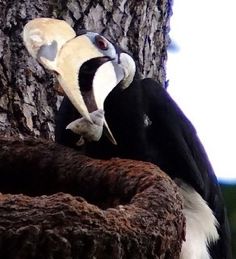On the morning of 15th February 2007 KC Tsang was at Changi documenting the food the male Oriental Pied Hornbill (Anthracoceros albirostris) was bringing to the female who was actively walling herself up inside the nest cavity. The bird brought the usual pieces of mud, insects and lizards for the busy female inside.
What puzzled KC was a non-food item the male brought in his bill. It was the upper part of an empty snail shell (left). The male displayed it to the female and then gently dropped it inside the cavity. Was it a gift of a ”toy” for his mate to play with?
This behaviour has been documented in Kg Gajah, Perak, Malaysia some years ago. As Dr Chan Kai Soon wrote, “…we noted the same thing (shells of snails) being delivered into the nest. We also thought that the male did this to provide calcium in the diet.” The shell piece was that of a land snail.
There is also an old report in the literature that the male Silvery-cheeked Hornbill (Bycanistes brevis) of Africa regularly brought inedible objects to the nest, like pieces of tree bark and sticks. Why? Probably as playthings.
It has now been established that calcium is an essential element in the diet of birds, especially those that do not obtain it from their primary diet. They thus seek out sources of this element during the egg laying and nesting periods. Various species of birds have been known to seek out calcium, the best example being the Scarlet (Ara macao) and Red-and-Green (Ara chloroptera) Macaws that take chunks of mineral-rich clay from steep river banks in Peru.
There are also published accounts of Black-capped Chickadee (Poecile atricapilla) eating ash that is high in calcium and Anna’s Hummingbird (Calypte anna) feeding on calcium-rich sand. And Arctic sandpipers use the teeth and bones of brown lemmings as a source of calcium.
The favourite food of hornbills is figs (above left). And figs are rich in water, carbohydrates and calcium. The presence of fig wasps inside the tiny fig flowers/fruits (above right) may provide added calcium. But I suppose, during breeding, the female needs more calcium than usual, thus the extra supply in the form of snail shells. And there are also the developing chicks to cater to.
Input by KC, YC and Dr Chan Kai Soon. Image of hornbill by KC and that of figs by YC.











2 Responses